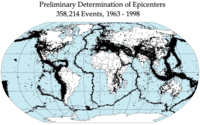
Photo from wikipedia
BACKGROUND Previous research has examined the association between parents' and children's posttraumatic stress disorder symptoms (PTSS) after a variety of traumatic events. However, longitudinal parent-child dyadic studies are scarce. METHODS… Click to show full abstract
BACKGROUND Previous research has examined the association between parents' and children's posttraumatic stress disorder symptoms (PTSS) after a variety of traumatic events. However, longitudinal parent-child dyadic studies are scarce. METHODS Independent self-reports were collected from parent-adolescent dyads (n = 688) after the 2008 Wenchuan earthquake. Adolescents (Mean = 15.22 years; 61.63% female) and one of their parents (Mean = 41.04 years; 58.14% female) each reported on their PTSS at 12 (T12m) and 18 months (T18m) following the earthquake. Longitudinal actor-partner interdependence models (APIMs) were used to examine PTSS within dyads. RESULTS The prevalence rates of probable PTSD at T12m and T18m were 18.90% and 11.92% in adolescents; as well as 22.09% and 15.12% in parents, showing a significant decline over time. After adjusted for earthquake exposure, both maternal and paternal PTSS at T12m prospectively predicted adolescent girls' and boys' PTSS at T18m (mother to daughter: β = 0.13; mother to son: β = 0.17; father to daughter: β = 0.17; father to son: β = 0.33), while adolescent girls' and boys' PTSS at T12m only predicted maternal PTSS at T18m (daughter to mother: β = 0.20; son to mother: β = 0.20), but not paternal PTSS at T18m. LIMITATIONS Self-reported measures other than clinical reviews were used to collect data. CONCLUSIONS This study highlights the mutual impacts of adolescent and parental (especially maternal) PTSS after a disaster. Psychological prevention and intervention for adolescent disaster survivors should adopt a whole family approach.
Journal Title: Journal of affective disorders
Year Published: 2018
Link to full text (if available)
Share on Social Media: Sign Up to like & get
recommendations!